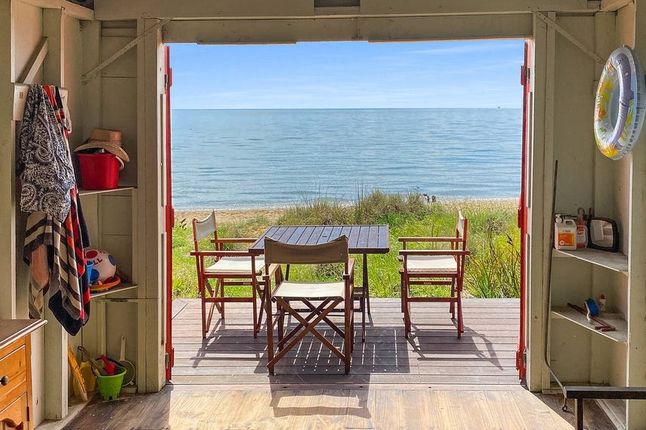They might be uninhabitable, and lack even electricity or running water, but these beachside sheds have become a hot downsizing trend and are fetching prices on par with Australia’s median dwelling value.
Buyers on Victoria’s Mornington Peninsula are paying a premium to secure their summer by the sea, lured by glistening waters and dreams of sundowners by the bay.
There’s been a spate of recent eye-watering prices realised for beach shed sales, which locals say has in part been sparked by a COVID-19 induced sea change trend.
On November 7, a buyer shelled out $570,000 for a beach shed at Rye’s Tyrone Beach (known as Boatshed 68) for more than twice the asking price.

The underbidder in that hot auction continued undeterred in his bid to lap up summer in style, a week later nabbing Boatshed 61 just a short sand stroll away.
That beach shed was originally listed for $269,000-$295,000 but had its reserve revised to $470,000 ahead of its 14 November auction. One bid of $350,000 was offered, but the property passed in, selling later for an undisclosed sum.

Also, on November 8, a tiny beach shed at 4 South Beach, Mount Martha, was snapped up for an eye watering $650,000.
Hockingstuart Belle Property’s Tim Bradler, who marketed beach shed 61 at Rye, said the buyer already had a house in the area and was keen to snap up the bright blue and white box to entertain family.
“It’s for his grandkids and kids to enjoy,” Mr Bradler said.
“He’s got a house only a street away and rather than having to cart all their gear backwards and forwards, they’ll get use out of it.”
There's still time to make a purchase, with beach shed number 62 currently on the market for $395,000-$430,000.

Beach sheds (also known as beach boxes) are mostly used by their owners to store beach equipment, boats, as a change room and shelter.
They contain no bedrooms or bathrooms and while some on the peninsula have electricity, ones without cannot be connected.

Buyers purchase a licence giving them the right to occupy the site and do not own the land on which they are built.
The licence comes with conditions, including that the structure is maintained well and an annual site fee and municipal charges are paid.
Beach sheds 'flavour of the month'
Mr Bradler says the reason beach boxes are sought after is because they rarely come up for sale.
“They’ll be the flavour of the month. You’ll get one, two or three and then they’ll go and none will come up for a while. Or you’ll just get one random one,” he says.
“They always just go up in value and people hold onto them, some of them have them for generations, others keep them for a few years and then sell them. The majority of them are long held.
They have been the most consistent investment that people have made on the peninsula we see. It doesn’t seem to matter what the market is doing, boatsheds just stay on the same trajectory.”
There are about 1,200 beach boxes scattered along the peninsula, mostly on Crown land and they are managed by the local shire or state government foreshore committees.

Many have historical and coastal significance.
Buyers scampering to buy these iconic waterfront properties seem unfazed that they can cost almost as much as a house.
According to CoreLogic, Australia had a median dwelling price of $686,339 in October, and a median unit price of $593,000, which is not far off the prices achieved for these sheds.
Boxes built in 1950s
Local agent Craig Evans says growth in peninsula boat sheds over the last 20 years has been better than houses.
Wannabe owners have even been known to slide notes under the doors to see if one's for sale.

“It’s not uncommon,” says Mornington Peninsula Beach Box Association president Mark Davies.
“The boxes were built in the 1950s and they were built right around the bay.
“Typically they're not being built anymore, so there's a scarcity to them.”
Recent prices are being driven by lifestyle decisions, Mr Davies said.
"Since the one sold for $570,000, we've definitely seen a couple of others come on the market. It's a bit of opportunism there," he said.
Anyone can own a beach box on the peninsula, but the local shire is proposing they only be owned by ratepayers.

Mr Davies says changes flagged by the shire have been controversial for current owners and talks are underway with the state government about introducing consistent rules and guidelines across Port Phillip Bay.
"With boatsheds, there's a great romanticism about them," he said.
"However, they exist on perhaps the harshest part of our continent, right on the seashore so they're exposed to winds, salt air, rain and bay storms.
“People see the bright colours and look at the romantic side of it but people spend a lot of time and love and effort to maintain them.
“That can be an issue when people age and they're not being maintained, they may want to sell them.”
Mr Davies said owners may be taking advantage of the pandemic, which has led coastal property to skyrocket, to sell up.
FIND OUT MORE:
- Read Downsizing.com.au's Mornington Peninsula guide
- Discover the stunning coastal communities where downsizers can mix work and pleasure
- Discover the sea change downsizing hotspots which have boomed since COVID-19
- Time for a seachange? NSW's best beaches
- 'Sleepy hollow' no more: How to find the perfect downsizer home in the booming Geelong region


